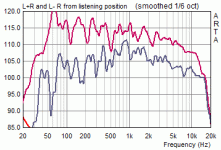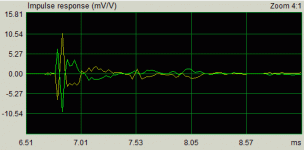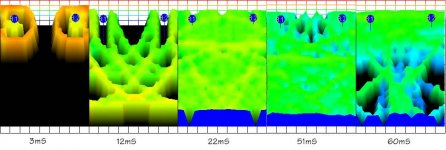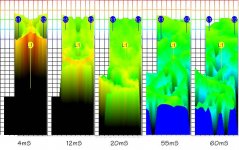How can there not be a diffuse field in a small room ?
Because of the physical characteristics that define the acoustically small room. It's simply not diffuse enough (a concert hall is) for diffuse field measures to be meaningful. "[Diffuse] means it is homogeneous (the same everywhere in the space) and isotropic (with sound energy arriving at every point equally from all directions). An acoustically small room has none of these properties.
There are references in Toole's paper.
As long as we keep on arguing and using diffuse field concepts we won't get any closer to answering any question of real importance like "What is the optimal reflection pattern?"
Last edited:
You're just resurrecting the same debate that occurred many pages ago between Earl and Dave S, with no new information.Because of the physical characteristics that define the acoustically small room. It's simply not diffuse enough (a concert hall is) for diffuse field measures to be meaningful. "[Diffuse] means it is homogeneous (the same everywhere in the space) and isotropic (with sound energy arriving at every point equally from all directions). An acoustically small room has none of these properties.
Let me pose this thought though - there is a slowly decaying diffuse field within a small room which is homogeneous and isotropic, but superimposed on top of this are the early and late reflections.
Look again at the ETC curves that we all posted way back. For the first 30ms or so there are discrete reflections superimposed above the diffuse field, and feeding into the diffuse field, but there is a diffuse field all the same which builds up to a maximum well before 30ms. After about 30ms it is entirely random and almost linear in decay, because no individual reflection is stronger than the reflections as a whole. (The "diffuse field")
Earl tried to argue that in a small room the diffuse field didn't get a chance to build up before the RT60 time is gone, but in fact the diffuse field will build up more quickly in a small room than a very large one because each ray will go through more semi-randomized reflections per unit of time than the large room.
You only have to look at the ETC curve to see just how rapidly the diffuse field builds up, and it is fully built up by the time the last obvious early reflection has passed.
In the same time that a ray might travel in a straight line in a concert hall before first hitting something, it may have bounced off 10-15 different room surfaces in a small room with its direction relative to source having become well and truly chaotic, especially if there are objects in the room and its not just a smooth empty shoe box.
I maintain that it's perfectly valid to consider the diffuse field of a small room in addition to and separately from the early reflections, and I thought that was the outcome last time around when this point was debated...
I don't understand why you keep trying to write off the reverberant field as unimportant.
Last edited:
Complex setups of multiple paths and combinations/mixes of :What tools are you using for creating virtual rooms?
- channel matrixing (2-->2)
- partial speaker crosstalk cancellation and phantom source mechanism dependant re-spacialisation (my own algorithms, basically just a little cross-convolving)
- early reflections / reverbs (notably RoomMachine844 and KR-Reverb FS, the latter is special in that it modulates the reflection times a bit, just like real-world outdoor reflections do, from wind and/or moving surfaces, which makes the reverb less static. This also make sampling of the response with a dirac not working in the same way as the plug does in realtime because it's not time-invariant)
- delays
- EQs
Essentially the same processes that any sophisticated sound engineer/producer is using to "beef up the stereo" (eg in the electronica genre), only that I don't have the individual tracks of a recording.
Basically I try to extract different "source components" from stereo signals, which then feed the reflections/reverbs, some of which get respatialized, as does some of the original content. By this I can give different dL/dT signal combinations different "spaces" to live in, as well as the added reverbs are dL/dT dependent and get their own/different spaces, too. I can dial in different space projections, for the more direct (XY-based) content of the original, the more diffuse content (AB-based or fully decorrelated) of the original, and for the added stuff.
Simplest form of this, for example, is feeding two 1in-->2out stereo reverberators with delayed M/S-signals and then placing their output in the mix.
Simplest setup is in a straight 2in, 2out VST-plugin chain which is limited in variability but provides enough capabilites for a starting point. For the more complex creations I use H.Seib's VSTHost but I'm about to switch over to the Bidule environment which seems to allow the most flexibility of routings and is quite easy to use.
While it is very creative to play with these things you can get lost quickly in that wealth of possiblities....
You're just resurrecting the same debate that occurred many pages ago between Earl and Dave S, with no new information.
Let me pose this thought though - there is a slowly decaying diffuse field within a small room which is homogeneous and isotropic, but superimposed on top of this are the early and late reflections.
Look again at the ETC curves that we all posted way back. For the first 30ms or so there are discrete reflections superimposed above the diffuse field, and feeding into the diffuse field, but there is a diffuse field all the same which builds up to a maximum well before 30ms. After about 30ms it is entirely random and almost linear in decay, because no individual reflection is stronger than the reflections as a whole. (The "diffuse field")
Earl tried to argue that in a small room the diffuse field didn't get a chance to build up before the RT60 time is gone, but in fact the diffuse field will build up more quickly in a small room than a very large one because each ray will go through more semi-randomized reflections per unit of time than the large room.
You only have to look at the ETC curve to see just how rapidly the diffuse field builds up, and it is fully built up by the time the last obvious early reflection has passed.
In the same time that a ray might travel in a straight line in a concert hall before first hitting something, it may have bounced off 10-15 different room surfaces in a small room with its direction relative to source having become well and truly chaotic, especially if there are objects in the room and its not just a smooth empty shoe box.
I maintain that it's perfectly valid to consider the diffuse field of a small room in addition to and separately from the early reflections, and I thought that was the outcome last time around when this point was debated...
I don't understand why you keep trying to write off the reverberant field as unimportant.
I've never said that the reverberant field is unimportant, it's of great importance and the important information is in its structure, not in a single measure like RT60 or D/R ratio.
I don't want to resurrect the same debate I just would like to see people accepting physical facts. Obviously not everybody does. Compare the ETC and the directional components of a acoustically small space to that of a concert hall and you'll see the difference.
Last edited:
You should read Sabine's book on acoustics and the account of how he first experimented and came across the the basic concept or RT. He was trying to "do something about the sound" of a small recital hall. He was certain that absorptive material of sime kind would help and he was dragging in a number of large horse-hair bench seat cushions. While a pianist played he and the college officials judged the sound quality. I went something like "we found that 9 cushions was to many but 7 was just right". Later he went on devise a measurement of room reverberence. He basically had organ pipes as sound sources and pushed and released a button on a paper chart to correspond with the signal turning off and subsequently becoming inaudible. Later he figured out the "becoming inaudible" corresponded to about a 60dB drop so that became the definition of RT. The book is a great read and it shows a great mind's methodical approach to empirical science.
So acoutics developed and people were happy designing concert halls based on Sabine concepts until about the 1940s or 50s, when a number of larger halls "went bad". It took through the 80s for acousticians to push forward another level and find the cause of innadequacies of RT alone. Large fan shaped halls can have the right RT but be totally lacking in lateral reflections (early shoebox halls didn't have that problem). It was also found that the early part of the decay rate, RT30 or 20 was more important and some halls might have the right ultimate rolloff but were deader in their initial decay.
I think the way to look at it is that RT alone won't guarantee good acoustics but a wrong RT will exclude them. Its the macro/micro thing again. Even the Toole quote can be read that way. Acoustical hardness of our wall surfaces (and room volume) determine how long the sound hangs around and the strength of every reflection. Looked at the other, a longer RT means those reflections, early or late, are stronger and more sustained. What direction and how loud the earliest reflections are, is the most direct view of our subject, but the overall level of the reverberent field is the broad view of that. Its also something we can easily measure and compare.
David S.
So acoutics developed and people were happy designing concert halls based on Sabine concepts until about the 1940s or 50s, when a number of larger halls "went bad". It took through the 80s for acousticians to push forward another level and find the cause of innadequacies of RT alone. Large fan shaped halls can have the right RT but be totally lacking in lateral reflections (early shoebox halls didn't have that problem). It was also found that the early part of the decay rate, RT30 or 20 was more important and some halls might have the right ultimate rolloff but were deader in their initial decay.
I think the way to look at it is that RT alone won't guarantee good acoustics but a wrong RT will exclude them. Its the macro/micro thing again. Even the Toole quote can be read that way. Acoustical hardness of our wall surfaces (and room volume) determine how long the sound hangs around and the strength of every reflection. Looked at the other, a longer RT means those reflections, early or late, are stronger and more sustained. What direction and how loud the earliest reflections are, is the most direct view of our subject, but the overall level of the reverberent field is the broad view of that. Its also something we can easily measure and compare.
David S.
I think the way to look at it is that RT alone won't guarantee good acoustics but a wrong RT will exclude them. Its the macro/micro thing again. Even the Toole quote can be read that way.
It should be read that way but I even doubt that RT is describing things corrrectly on the macro level. The different "versions" of RT show that we don't measure the right thing.
I think Laurie Fincham and Mike Berman wrote up the procedure in one of their papers.
David S.
I'm familiar with Eric Benjamin's paper from Dolby. I think Stereophile even wrote up on it at one time.
Benjamin, E., Extending Quasi-Anechoic Electroacoustic Measurements to Low Frequencies, AES Convention paper 6218, 2004.
I am a bit late, but just for the records - this is what I measure at home:
Left and right each:

Sum and difference:

Both impulses (one inverted):

Does anybody know, why everybodies +/-comparison converges in the bass region, while mine diverge?
Rudolf
Left and right each:
Sum and difference:
Both impulses (one inverted):
Does anybody know, why everybodies +/-comparison converges in the bass region, while mine diverge?
Rudolf
Attachments
Diffusion in the Room
I was wondering a bit about the diffuse field in a small room so I ran CARA sims on 3 rooms of similar sizes but different layouts. Two are shown below, my room and a friend's.
The room sims are not stuffed with all the furniture, books, busts of Beethoven, etc that the real rooms are, so they are basic. I also ran a stock room (not shown) that came supplied with the software that is much more complex and takes longer to calculate. All 3 were similar. I can post the more complex room if anyone is interested.
You are looking into the room form the back wall behind the listener. The speakers are indicated by the blue pins.
The sims show a Dirac pulse thru time. The direct sound hits the listener at 10-12mS and by about 22mS a diffuse field is built up. That diffuse field lasts until about 60mS in all 3 rooms then starts to fall apart.
For your amusement, I thought you might like it.
I was wondering a bit about the diffuse field in a small room so I ran CARA sims on 3 rooms of similar sizes but different layouts. Two are shown below, my room and a friend's.
The room sims are not stuffed with all the furniture, books, busts of Beethoven, etc that the real rooms are, so they are basic. I also ran a stock room (not shown) that came supplied with the software that is much more complex and takes longer to calculate. All 3 were similar. I can post the more complex room if anyone is interested.
You are looking into the room form the back wall behind the listener. The speakers are indicated by the blue pins.
The sims show a Dirac pulse thru time. The direct sound hits the listener at 10-12mS and by about 22mS a diffuse field is built up. That diffuse field lasts until about 60mS in all 3 rooms then starts to fall apart.
For your amusement, I thought you might like it.
Attachments
Mine are diverging below 200Hz, too. I think part of the reason could be that we both are using dipoles in the bass ?Does anybody know, why everybodies +/-comparison converges in the bass region, while mine diverge?
Mine are diverging below 200Hz, too. I think part of the reason could be that we both are using dipoles in the bass ?
Klaus, I noticed that. That's why I didn't dump it immediately in the "faulty measurements" bin.
But I'm not yet sure what insight to cull from it.
Rudolf
It looks like you've shown individual impulses of left and right speakers with one reversed in phase ? I'm not sure if you were trying to produce something that could be compared to my impulse response, but if so I was measuring something different - one impulse was from my Left+Right measurement and the other from my Left-Right measurement.I am a bit late, but just for the records - this is what I measure at home:
Left and right each:

Sum and difference:

Both impulses (one inverted):

In any case it looks like you have quite good symetry there apart from one reflection in one channel at 7.53ms on the axis.
Not everyone's in and out of phase measurements converge in the bass region - mine clearly don't, where you can see a rapid downwards slope below ~90Hz in the out of phase connection of around 24dB/octave.Does anybody know, why everybodies +/-comparison converges in the bass region, while mine diverge?
The reason for this divergence is because the out of phase connection reverses any lobes and nulls in the combined polar response formed by the pair of speakers.
If they were connected in phase this means below the frequency where they are a half wavelength apart no nulls can form in their combined polar response. (~90Hz for speakers 1.8 metres apart as mine are) When phase is reversed, no lobes can form instead, so you get almost no output, hence a very rapid fall off below this frequency.
What puzzles me is not why some peoples results don't diverge at low frequencies as they should, and I suspect there is something funny going on with the measurements, or the cancellation between the speakers at low frequencies is poor, probably due to room effects.
In Markus's measurements the noise floor is too high at low frequencies and because he's only measuring a pair of satellites with no real bass response, the divergence that should be seen is below their operating range, and also masked by the noise floor.
Pano's results puzzle me - neither convergence or divergence at bass frequencies.
KSTR's results look as expected to me - there is obvious divergence at bass frequencies.
Wintermute's results show obvious divergence below about 60Hz - consistent with a speaker spacing of roughly 2.5 metres.
Dave's results don't show the divergence I'd expect in the bass, but he's using different software to everyone else so if I had to guess I would say that maybe there are problems with noise floor at bass frequencies in those readings, as an actual RTA reading is not going to have as much ambient noise rejection as something like the random phase multisine (noise based impulse response) mode of ARTA.
Not sure whats going on in the bass in ra7's measurements, perhaps a combination of noise floor encroaching on the measurement as well as asymmetric room modes caused by an irregular shaped room or largely offset speaker positions in the room.
There's as much variation in the bass cancellation for different respondents as there is at higher frequencies. Some may be the use of different software and measurement techniques but some will also be fundamental differences in rooms...(symmetrical vs asymmetric rooms etc)
Last edited:
Don't forget that mine is ~15dB in the bass, same as Rudolf. It just does not change much as the frequency goes higher.Pano's results puzzle me - neither convergence or divergence at bass frequencies.
We could all use either HOLM or ARTA, or both. Both are free and easy to use. That might help.
I don't feel comfortable to say this to some people that are such great sources of knowledge, and always kind, but manifestly, they have to take more care of their rooms and speakers. If they can't reproduce a simple phase opposition in low frequencies, what about music ? Because, as everybody knows, in the low frequencies, the room response is the response.
Correct me if I'm wrong, but when both acoustic signals add in phase, isn't that a 3dB increase? But even out of phase, the signals will only cancel at a tiny point in space up to 20kHZ. What's the half wavelength of 20kHZ in distance? About 1/2 inch? If you're off center at all, the high end will start comb filtering. Since both ears can't fit into a 1/2 inch space, the test has its limits. It's a revealing test, especially if everyone's aware of how to interpret the results. Maybe I misunderstood something?That's the whole point of the measurement - when we measure out of phase only the direct signal from the speakers will cancel completely, all reflections, except perhaps perfectly symmetrical early reflections (like the floor bounce) will arrive at essentially random phase angles and time delay and therefore will not cancel.
What we're left with is a good approximation of the reverberant field.
When we measure in phase we get the direct signals summed together (6dB addition) plus the reverberant field.
Correct me if I'm wrong, but when both acoustic signals add in phase, isn't that a 3dB increase?
Yes, see this calculator.
Err, no.
Acoustic signals of equal amplitude and in phase add to a 6dB increase. For example two in phase sine waves. (90 degrees gives a 3dB increase, 120 degrees gives no increase, 180 degrees gives cancellation...)
Acoustic signals of equal amplitude and random phase relationship (uncorrelated or incoherent addition) statistically average to adding their powers - eg 3dB, if their phase relationship varies randomly or there are enough different versions of the signal with random phase distribution. (Eg large numbers of different room reflections)
For example adding together two sources of uncorrelated pink noise which are equal in average amplitude and spectrum, but have a randomly varying phase relationship to each other will add to a 3dB increase.
(Anyway, the link you provided clearly says adding uncorrelated signals)
Last edited:
Well, if you ever tried a slow mono sine sweep (which is a test as stringent as the cancellation test) and noticed that even in the very best setups (with DSP correction and all) the localization of that sine sweep greatly bounces around the ideal phantom center varing with frequency... then you know that this perfect symmetry is really very hard to achieve. BTW this is even often hard to achive with a mono center speaker. For example when one side wall is not rigid but has some frequency dependant behaviour it is physically impossible that the cancellation test or mono sweep test passes without flaws.I don't feel comfortable to say this to some people that are such great sources of knowledge, and always kind, but manifestly, they have to take more care of their rooms and speakers. If they can't reproduce a simple phase opposition in low frequencies, what about music ? Because, as everybody knows, in the low frequencies, the room response is the response.
With music reproduction these room-related ill-effect are much less perceived as annoying as with noise or sweeps, to our rescue.
- Status
- This old topic is closed. If you want to reopen this topic, contact a moderator using the "Report Post" button.
- Home
- Loudspeakers
- Multi-Way
- What is the ideal directivity pattern for stereo speakers?




